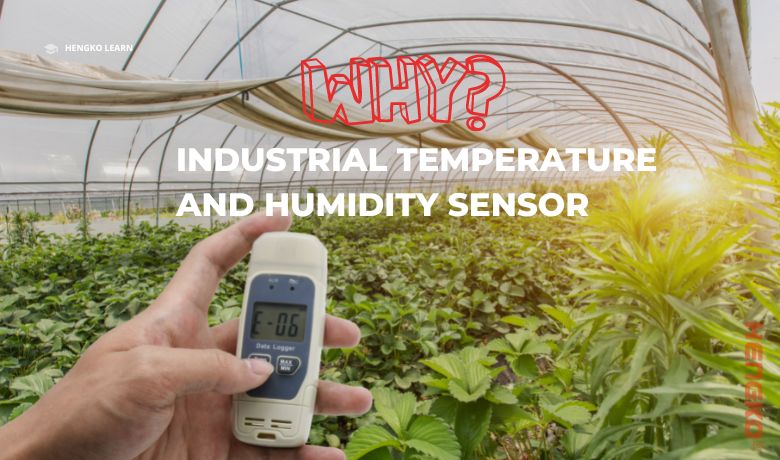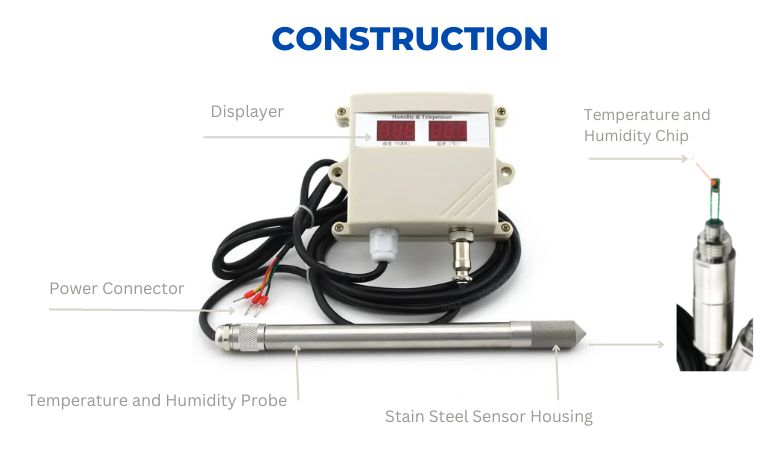
Industrial processes rely heavily on accurate measurements of various environmental parameters. Temperature and humidity are two such parameters that are crucial for maintaining the quality and safety of industrial processes. Industrial temperature and humidity sensors are used in various applications such as HVAC systems, agriculture, automotive, etc. Here we will explore the importance of using industrial temperature and humidity sensors and the differences between temperature and humidity meters and sensors.
Why to Use Industrial Temperature and Humidity Sensors?
Consistent Quality Control:
Temperature and humidity sensors ensure consistent quality control in industrial processes. For instance, in food processing, the moisture content and temperature of the ingredients directly impact the quality and safety of the final product. Industrial temperature and humidity sensors can accurately measure these parameters and help maintain the desired quality.
Improved Energy Efficiency:
Industrial temperature and humidity sensors can help reduce energy costs by ensuring optimal temperature and humidity levels. For instance, temperature and humidity sensors in HVAC systems can help regulate indoor air quality and reduce energy consumption.
Prevent Equipment Damage:
High temperatures and humidity can damage industrial equipment and machinery. By using temperature and humidity sensors, operators can monitor and control these parameters to prevent equipment damage and extend the lifespan of machinery.
Safety:
Industrial processes often involve hazardous materials or environments. Temperature and humidity sensors can help monitor these environments and ensure the safety of workers and the surrounding area.
What is Industrial Temperature And Humidity Sensor?
Industrial temperature and humidity sensors measure and monitor temperature and humidity levels in industrial environments. These sensors are designed to withstand harsh environmental conditions, such as high temperatures, dust, and moisture, which are common in industrial settings. Industrial temperature and humidity sensors are used in various industries, including manufacturing, pharmaceuticals, food processing, and agriculture.
Temperature and humidity sensors are used to monitor environmental conditions to optimize processes, ensure product quality, and prevent damage to equipment. Accurate temperature and humidity measurements are important for many industrial processes, such as HVAC, refrigeration, and drying.
What is the Difference Between Industrial Temperature And Humidity Sensors in households?
The main difference between industrial temperature and humidity sensors and household sensors is their design and durability. Industrial sensors are designed to withstand harsh environmental conditions, such as high temperatures, dust, and moisture, which are common in industrial settings. They are typically made of rugged materials, such as stainless steel or aluminium, and are designed to be mounted in place.
Household sensors, on the other hand, are typically designed for use in indoor environments and are not designed to withstand harsh environmental conditions. They are usually made of plastic or other lightweight materials and are designed to be portable or easily mounted on a wall.
Industrial sensors also typically have higher accuracy and precision than household sensors, as they are used in critical industrial processes that require precise temperature and humidity control.
How many kinds of Industrial Temperature And Humidity sensors?
There are several different types of industrial temperature and humidity sensors, including:
Capacitive sensors:
These sensors measure humidity by detecting changes in capacitance between two electrodes as humidity levels change. They are commonly used in HVAC systems and other industrial applications.
Resistive sensors:
These sensors measure humidity by detecting changes in resistance caused by changes in humidity levels. They are commonly used in industrial drying processes and other applications where accurate humidity control is important.
Thermal conductivity sensors:
These sensors measure humidity by detecting changes in the thermal conductivity of a material as humidity levels change. They are commonly used in industrial applications where high humidity can cause damage to equipment or products.
Optical sensors:
These sensors measure humidity by detecting changes in the refractive index of a material as humidity levels change. They are commonly used in industrial applications, such as pharmaceutical manufacturing, where accurate humidity control is important.
What is Humidity Sensor Construction ?
Humidity sensors typically consist of a sensing element and a measurement circuit. The sensing element is designed to detect changes in humidity levels, while the measurement circuit converts the sensor output into a measurable signal, such as voltage or current.
The sensing element can be constructed from various materials, including ceramics, polymers, and metals. The choice of sensing element material depends on the specific application requirements, such as temperature range, humidity range, and chemical compatibility.
The measurement circuit typically consists of an amplifier, filter, and signal conditioning circuitry. The amplifier amplifies the sensor output while the filter removes any unwanted noise or interference. The signal conditioning circuitry converts the amplified and filtered signal into a measurable output signal, such as voltage or current.

What Are the Main Features of Industrial Temperature And Humidity Sensors?
The main features of industrial temperature and humidity sensors include the following:
High accuracy and precision:
Industrial sensors are designed to provide accurate and precise temperature and humidity measurements, critical for many industrial processes.
Durability:
Industrial sensors are designed to withstand harsh environmental conditions, such as high temperatures, dust, and moisture, which are common in industrial settings.
Reliability:
Industrial sensors are designed to be reliable and provide consistent performance over time, which is important for maintaining process control and product quality.
Low maintenance:
Industrial sensors are designed to require Humidity Sensor for Industrial Applications
HVAC Humidity Sensor:
In HVAC systems, humidity sensors monitor and control indoor air quality. These sensors can help prevent mould growth and other harmful microorganisms by maintaining optimal humidity levels.
Industrial Soil Moisture Sensor:
In agriculture, soil moisture sensors are used to determine the optimal time for irrigation. These sensors can help farmers conserve water and improve crop yield by ensuring plants receive good water.
Automotive Humidity Sensor:
Automotive humidity sensors are used to maintain the optimal humidity level inside a vehicle. These sensors can help prevent fogging on windows and improve the comfort of passengers.
Industrial High-Temperature Humidity Sensor:
High-temperature humidity sensors are used in industrial processes that involve high temperatures and humidity levels. These sensors can accurately measure the humidity level in these environments and help prevent equipment damage and safety hazards.
Industrial Temperature and Humidity Meter and Sensor: What’s the Difference?
Temperature and humidity meters and sensors are often used interchangeably but differ. A temperature and humidity meter is a handheld device that measures temperature and humidity levels in a given area. On the other hand, an industrial temperature and humidity sensor is a device permanently installed in an industrial process to monitor and control temperature and humidity levels continuously.
Temperature and humidity meters are useful for spot-checking and verifying the accuracy of industrial temperature and humidity sensors. However, industrial sensors provide real-time data that can use to optimize industrial processes and improve energy efficiency. Additionally, industrial sensors are designed to withstand harsh environments and can operate for long periods without requiring maintenance.
Conclusion
Industrial temperature and humidity sensors play a critical role in maintaining the quality and safety of industrial processes. These sensors help prevent equipment damage, improve energy efficiency, and ensure the safety of workers and the surrounding environment. Industrial operators can optimize their processes and improve their bottom line by using temperature and humidity sensors.
In summary, there are many reasons why industrial temperature and humidity sensors are essential in industrial applications. They help maintain consistent quality control, improve energy efficiency, prevent equipment damage, and ensure the safety of workers and the surrounding environment. It is important to note that temperature and humidity meters are different from industrial sensors, and both have specific applications. By investing in industrial sensors, operators can optimize their industrial processes and achieve their goals of increased efficiency, quality, and safety.
Send your message to us:
Write your message here and send it to us
Media Contact
Company Name: HENGKO
Contact Person: Media Relations
Email: Send Email
Phone: 0086-755-88823250
Country: China
Website: https://www.hengko.com/
